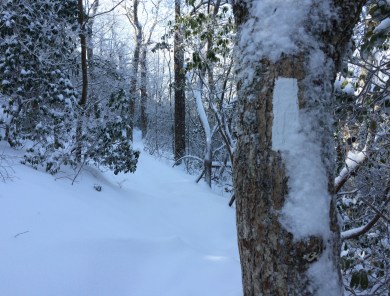Top of Georgia Hostel, Hiawassee, GA, Friday February 27, 2015 — A couple of days ago I marched into the woods to begin my duties helping hikers get through their first of the Appalachian Trail’s (AT) 14 states.
My duties are to educate hikers on Leave No Trace principles, which at its essence means that they are supposed to live in and leave the wilderness undisturbed by their presence. “Leave only footprints” is the mantra.
We also hike out trash we find, help where we can and be a friendly presence on the trail as well as eyes and ears.
The first day began at 9 a.m. at about 70 miles north of the AT’s start point on Springer Mountain. This section begins with a 1,500 foot climb right out of the door. It took about a nano second for me to fully appreciate that the 2,200 mile-strong “trail legs” earned on my thru hike last year were past their expiration date. Ooooph!
But I slushed on through the snow, stopping every 50 yards or so to cool down and catch my breath. I’m packing about 35 lbs. of cold weather gear, gaiters, food, stove, first aid kit, water purification pills, tooth paste and the like. Then there’s my trail saw, trash bags and bungee chords. Oof Da, as the Norwegians say.
First stop was to check the Deep Gap shelter and pick up some detritus left behind by hikers. Not much thank heaven. Then to push on to the Tray Gap shelter, about seven more miles up hill and ahead.
A storm was expected to roll in about 5 p.m., so no day dreaming was allowed.
The snow was typically heavy and wet southern snow ranging from four to eight inches deep with some drifting to a foot. My calves were screaming from pushing up hill and slipping back. What would have been a five hour hike on dry trail unfolded in just nine hours.
Of course the storm hit around four o’clock, an hour early. I arrived at the shelter covered in thick white stuff. Three hikers were there. They were strong and competent though the strongest among them told me that he’d been plowing Georgia snow for 12 days! That’s normally five to six days for most people just starting out.
I ate and took a deep dive into my down bag and reached slumber depth before anyone could say it’s snowing.
Throughout the night the wind whipped snow across my face, waking me occasionally. Who knew what we’d find in the morning.
The dawn sparkled with a fresh landscape of new snow, six to 12 inches adrift over everything. At least it looks good, I reasoned.
Now this has always been a family blog. But hikers have to do their business in the morning. Let’s just say that some mornings are easier than others.
The snowscape was inspiring.
Along the way I removed trail obstructions and noted some heavier work for later.
Wild pigs love to root and pillage.
Needless to say, the slogging was tiring. The smart decision was to push on another 8 miles and over another 1,500 foot climb to Unicoi Gap where I could get a ride back to the Top of Georgia Hostel where I’ve set up my base camp. I’d totaled only 20 miles.
Today is a zero day and the snow is melting. Tomorrow it’s back to Unicoi and another steep climb up Blue Mountain. We’ll see how far I get.
























